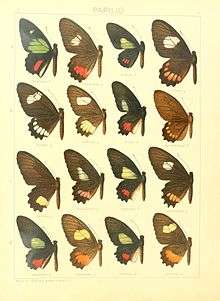Parides childrenae
Parides childrenae, the green-celled cattleheart, is a species of butterfly in the family Papilionidae.[2] It is found in southern North America and northern South America.
| Green-celled cattleheart | |
|---|---|
| Male | |
| Scientific classification | |
| Kingdom: | |
| Phylum: | |
| Class: | |
| Order: | |
| Family: | |
| Genus: | |
| Species: | P. childrenae |
| Binomial name | |
| Parides childrenae | |
Description
The upperside of the wings is black. The male has a bright green patch and a small pale yellow subapical spot on the forewing. There is a red patch on the hindwing. The female has a small white patch on the trailing edge of the forewing and a few pale subapical spots. There is a band of red spots across the hindwing. The underside of the wings is also black. The male has small pale subapical spots on the forewing and a few red spots on the hindwing. The female's underside is the same as the upper side.[2]
Description from Seitz
P. childrenae. The green area of the male is larger than in P. sesostris, covering also a part of the cell. The female has a transverse row of spots before the apex of the forewing, as well as two spots on the disc posteriorly. Distributed from Guatemala to Ecuador in two subspecies. — childrenae ' Gray (3 a) is the Central American form, which is found from Guatemala to Panama. Forewing of the male with a white spot before the apex. Band on the hindwing of the female bright red. — oedippus Luc. has in the male no white spot before the apex of the forewing, or only a very small one. In the female the band on the hindwing is a somewhat yellowish red on the inner side. Colombia and Ecuador.[3]
 Seitz
Seitz Original description
Original description
Description from Rothschild and Jordan(1906)
A full description is provided by Rothschild, W. and Jordan, K. (1906)[4]
Taxonomy
Parides childrenae is a member of the sesostris species group [5]
The members are
- Parides childrenae
- Parides sesostris
Etymology
The name honours Mrs Children
References
- Gray, R. G., 1832. In Griffith, E. The Animal Kingdom Arranged In Conformity With Its Organization, By The Baron Cuvier 14: 140 pls; 15: pp 1–796.
- Jeffrey Glassberg (2007). A Swift Guide to the Butterflies of Mexico and Central America. Sunstreak Books Inc. ISBN 978-1-4243-0915-3
- Seitz, A. ed. Band 1: Abt. 1, Die Großschmetterlinge des palaearktischen Faunengebietes, Die palaearktischen Tagfalter, 1909, 379 Seiten, mit 89 kolorierten Tafeln (3470 Figuren)

- Rothschild, W. and Jordan, K. (1906). A revision of the American Papilios. Novitates Zoologicae 13: 411-752. (Facsimile edition ed. P.H. Arnaud, 1967) and online
- Edwin Möhn, 2007 Butterflies of the World, Part 26: Papilionidae XIII. Parides Verlag Goecke & Evers Verlag Goecke & Evers ISBN 9783937783277
- Lewis, H.L. (1974). Butterflies of the World ISBN 0-245-52097-X Page 26, figure 4
External links
| Wikimedia Commons has media related to Parides childrenae. |
| Wikispecies has information related to Parides childrenae |